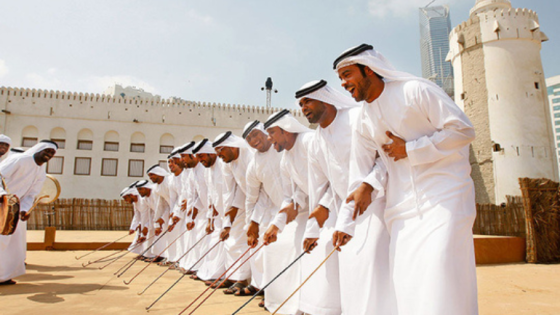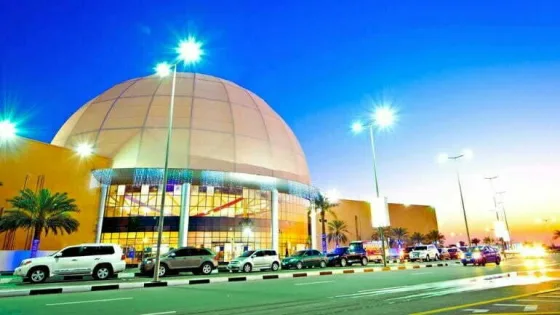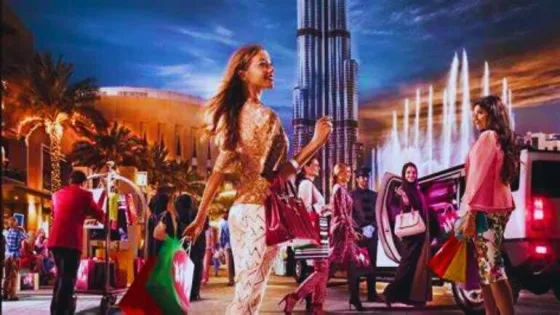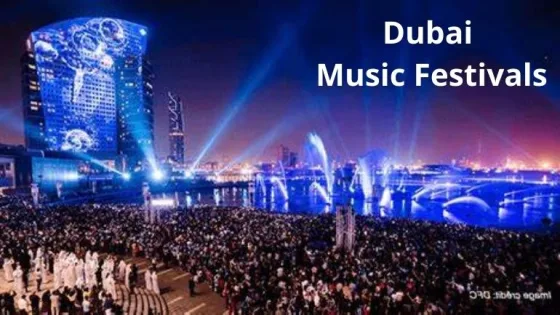Contents
- 1 UAE Dance History
- 2 UAE Traditional Dance
- 3 UAE Dance History Conservation
- 4 7 UAE Dances of Dubai That Manifest Emirati Culture
- 5 Al Ayyalah
- 6 The Haban
- 7 The Yolla
- 8 The Mated
- 9 The Liwa
- 10 The Harbiya
- 11 The Nuban
- 12 Ayyala in Abu Dhabi Culture
- 13 UAE Folk Dance
- 14 Lease Ayala Emirati Dancers for Events in Dubai and Abu Dhabi
UAE Dance has a rich artistic and historical culture. The country is blessed with a rich heritage and a vibrant culture that inspires everyone. This includes traditions, crafts, food, sports, archaeological and historical sites, and, not to mention, music and dance. The country has a rich history, and its inhabitants have turned to dance and music to convey their emotions. Among numerous traditional dance traditions, the Ayala dance will have you tapping your feet to the sounds and rhythm. If you want to learn more about the UAE’s national dance, the Ayala Dance, check out our brief guide!
Read more: UAE Festivals: A Vibrant Journey through Top 20 Dubai’s Cultural and Music Events
UAE Dance History
The UAE has a fascinating and rich cultural history, which may appear distant following the modern resurrection of cities such as Dubai and Abu Dhabi. Fortunately, there are individuals and groups in Dubai who are preserving their cultural history in one of the most meaningful ways: via traditional Emirati dance. Participating in traditional dance is extremely important to the people of the United Arab Emirates.
Dance has long been the most popular form of cultural expression, with traditional dances prominently featured on national holidays, weddings, festivals, and even friends’ gatherings. People in the UAE are deeply committed to preserving historical traditions for current and future generations. The ancient dances trace back to when the UAE’s inhabitants lived in the desert and faced hardship. Participating in music and dancing helped the desert people come together and conquer their obstacles.
Read more: Camel Racing UAE: Dubai Royal Camel Race Club Captures the Thrill in Photos
UAE Traditional Dance
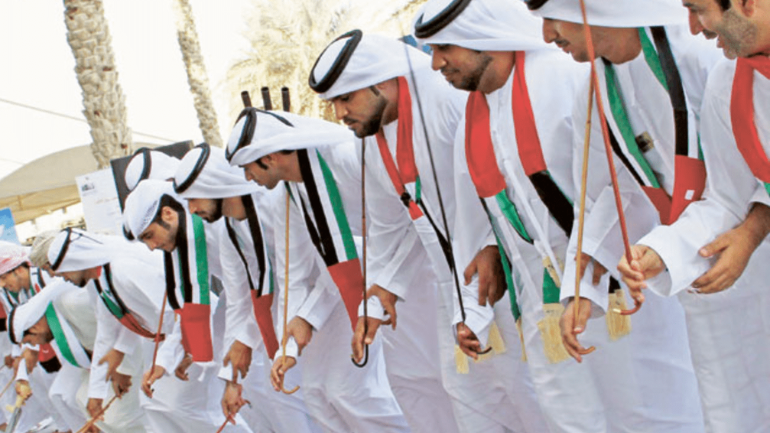
The UAE’s traditional dances are a one-of-a-kind art form that combines music, poetry, and dance to commemorate the nation’s spirit. The UAE dance tradition retains stories from the UAE’s history while maintaining ties to their ancestors’ tribal identities. Al Ayyalah, Yollah, Harbiyah, and Haban are among the UAE’s most popular traditional UAE dances. In addition, UAE Dance, with its vibrant rhythms and rich cultural heritage, embodies the soul of Emirati celebrations. From the spirited Ayyalah—where men sway to the beat of drums, swords in hand—to the captivating Yolla, these traditional dances connect past and present, uniting communities in joyous harmony. As modernization sweeps through Dubai and Abu Dhabi, these rhythmic expressions remain a testament to the enduring spirit of the Gulf region.
Read more: Dubai Sports Events: A Guide to the Best Sporting Events in the City
UAE Dance History Conservation
Many efforts are being made to preserve the UAE’s rich dance legacy, with the national government attempting to ensure that future generations can enjoy and participate in traditional dances. The UAE Ministry of National Heritage sponsors the Nation Folk Arts Group, which performs traditional dances within the Emirate and internationally.
Furthermore, the Al Ayyalah is so important in UAE history that it was added to UNESCO’s Representative List of Intangible Cultural Heritage Items in 2014. This acknowledges that traditional dancing is a component of the nation’s identity and heritage. This accreditation will aid in the transmission of dance expertise from one generation to the next, hence safeguarding dance values among UAE residents.
Read more: The Ultimate Guide to Dubai Ladies Nights: Where to Go and What to Expect
7 UAE Dances of Dubai That Manifest Emirati Culture
When discussing Dubai and its dance styles, we must consider the UAE as a whole. The UAE has a rich history of cultural dance, and its people have long expressed their feelings via diverse forms of dance and music. As a result, dance is extremely important to the inhabitants of the Gulf region. Locals use dance for weddings music and dance festivals, and, in many cases, celebrations. It is a kind of celebration that dates back to when the Indians lived in the center of the desert with nothing to show for it.
Their dance is an expression of celebration and rejoicing for what they have accomplished in recent years. With the urbanization of cities such as Dubai and Abu Dhabi, it is becoming increasingly vital to highlight the significance of this culture, which is exactly what the people have done. Here is a list of 7 Dubai Dances that will have you tapping your feet, forming a circle for a rhythmic motion, and dancing!
Read more: The Ultimate Guide to Dubai Family Travel Advice, and Must-See Attractions
Al Ayyalah
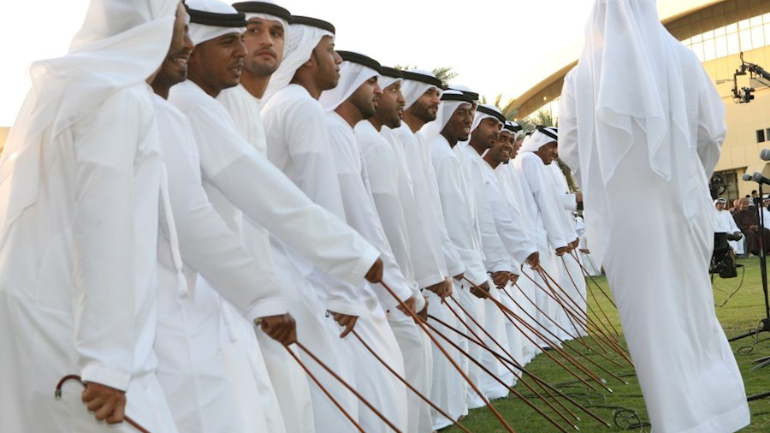
It’s also referred to as Al Ayala, Iyala, or the Stick Dance. The Ayyala dance form is one of the most well-known traditional dances in Dubai and the UAE. Al Ayala is a war-themed dance genre that begins with a deep beat from the Al Ras (big drum), which establishes the tempo for the smaller Takhamir drums. The dancing form is divided into two rows of guys standing in front of each other. The men in one row stand close together to demonstrate their solidarity and collaboration. These men then hold their spears or sticks, which depict blades of war, and sway them with their heads to the beats of the drummers. Additional dancers run up around or between the two rows, carrying sticks, spears, or weapons.
This dancing form is only performed by men, with a minimum of 25 and a maximum of 200 at a time. The dance is open to everyone, therefore people from all classes, castes, and races are welcome to attend. However, the position of dance leader is inherited, and they should train the other dancers. The amount of dancers in the ensemble determines how impressive the Ayyalah is. According to research, this theatrical dance genre originated in Najd, Saudi Arabia, and spread to the Emirates in the nineteenth century. Women have their version of this dance, in which they wear colorful gowns, sway their hair to the rhythm of the drum, and utter poetry or lyrics to remember the victory.
Read more: UAE Bird Watching Spots; best 8 places to visit and enjoy the view
The Haban
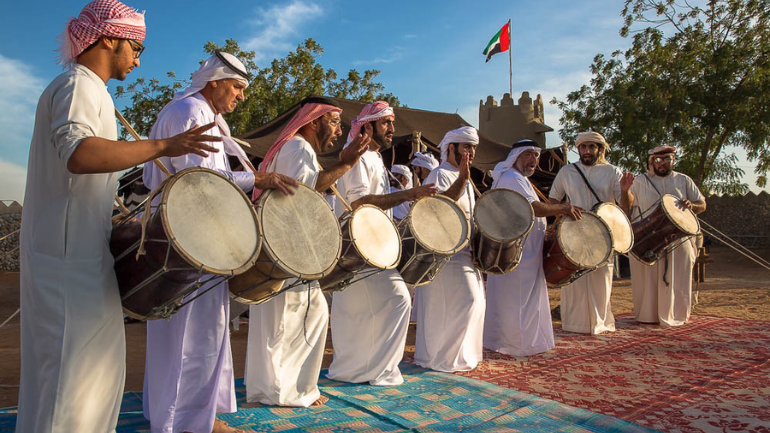
The name of this dance in Dubai comes from the principal stringed instrument that provides the beat and melody. Haban is a popular alternative dancing genre in Dubai. It is also known as Khayali or Khamiri. This dance type is commonly used at weddings and other special occasions. Haban is done in groups of three. The first group consists of eight males, the second group consists of eight females and the third group consists of ten musicians who play the song to which the men and women dance. There are unique musical instruments that accompany this dance and perform based on the performers’ efficiency. Both male and female teams move in a continuous two-step beat back and forth. The performance is frequently led by a conductor who is also a Haban or Jorba player.
Read more: Discover the Best Dubai Beach Wedding Venues, Plan Your Dream celebration
The Yolla
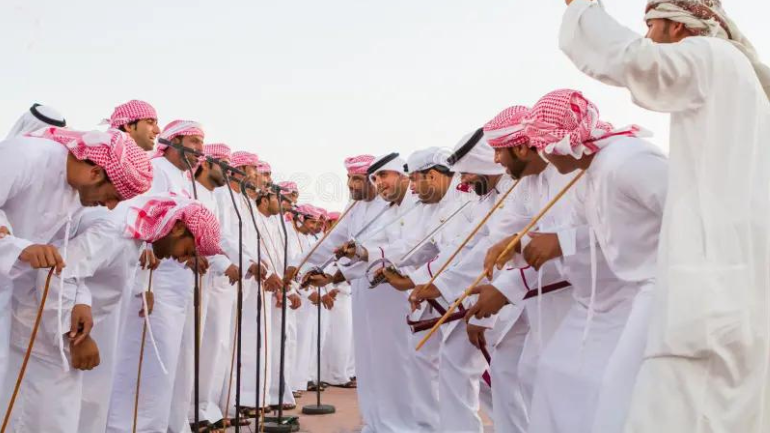
This Dubai dance, also known as Yowla or Yola, is similar to the Ayyalah in that it is intended to commemorate battle victories. This dance form consists of two or four rows of men facing each other, holding sticks, spears, or guns, and moving in time to musical instruments. The distinction begins with the instruments employed; in this case, the Doumbek (a drum made of goatskin stretched over a ceramic base) serves as the percussion part of the music, while the Oud offers the melody on the strings. The dancers move backward and forward, representing their successes and defeats in conflicts.
Read more: UAE Hot Springs: Discover Khatt’s Green Mubazzarah, a Hot Springs Resort Oasis
The Mated
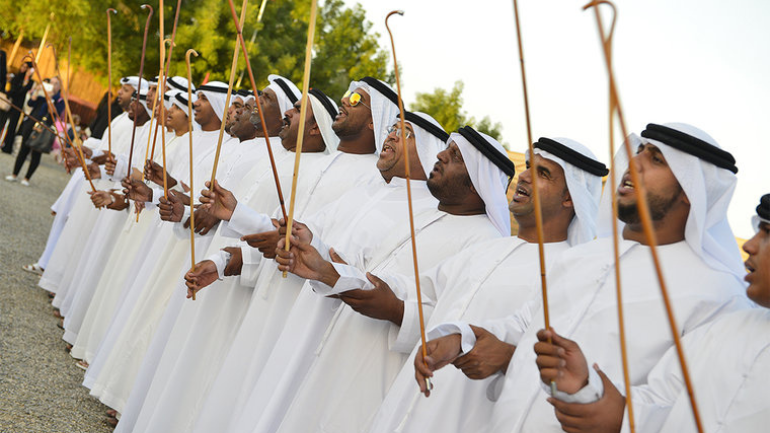
It is a popular dance style in both Dubai and Abu Dhabi. It derives from the word “mawlid,” which means “birthday of the prophet”. This dance genre differs from others in that it is only performed on religious occasions. Also, this type of dancing in Dubai can be dated back to the Sufi era. The dance is performed to win two separate categories.
The first section, known as the Matedal-Sira, comprises readings about the life of the prophet Mohammad. The second section is known as Mated al Samaa, which translates to the movement of pieces. Thirty individuals stand in two rows in front of each other; the first row is known as Ahl al Samaa, or “the hearing people,” and they recite while playing tambourines. The second row, known as the Al Radida or “the chorus,” repeats crucial lines from the first row’s recitation. The performance begins with the reciting of the Barda poem, which celebrates the prophet.
Read more: UAE Natural Wonders: Discover Dhabi’s Beautiful Natural Attractions
The Liwa
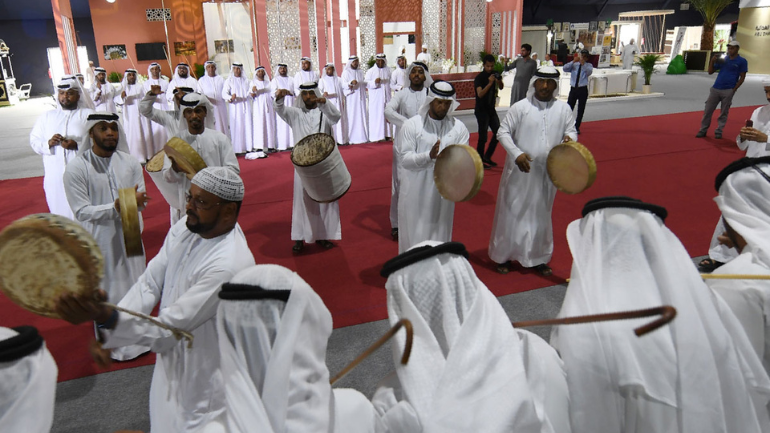
Liwa has a long history, dating back to when East African traders arrived in the Arabian Peninsula and carried this dance form with them. As a result, this dance genre exhibits African influences. One can see the numerous instruments utilized by the people for this dancing form, including a Mizmar (a flute-like instrument with a wide-open mouth) and three types of drums: Jabwah, Shindo, and Jasser. The Liwa dance form is commonly performed at wedding processions and other events.
The dance begins with 6 minutes of Mizmar performances, followed by the rhythms of three drummers before the 10 vocalists and dancers join in. After everyone has joined, the procession gathers up speed and reaches its peak intensity in around 20 minutes, when it concludes. A huge number of males create a circle, generally led by one or more drummers. A man stands in the center of the circle, playing a rudimentary reed instrument. The circle claps and dances and individuals form a line that moves rhythmically around the inside of the circle.
Read more: UAE Desert Landscapes: Experience Dubai Royalty in Photography
The Harbiya
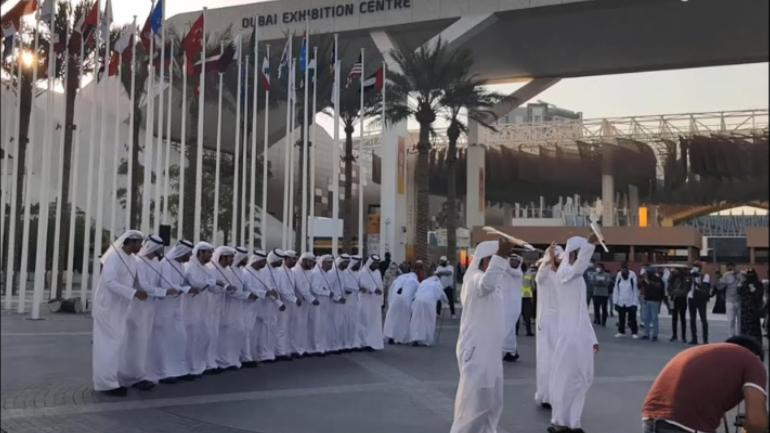
This kind of dance in Dubai is yet another variation of the Ayyalah, performed on special occasions. In this, two rows of men stand in front of each other, reciting unaccompanied melodic phrases. Between the two rows of soldiers, there is a group of people holding weapons, who punctuate the numerous recitations. If the number of dancers increases, the row begins to separate into ranks.
Read more: UAE Oasis Locations; Desert Oasis Al Ain Oasis Liwa Oasis locations oases in the UAE
The Nuban
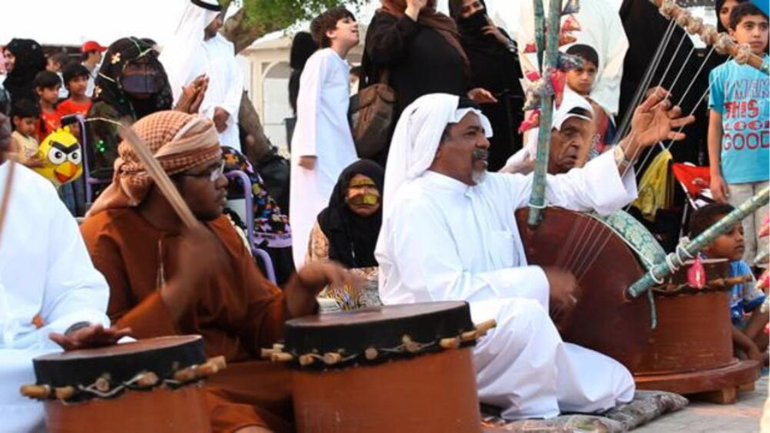
It is one of the most bizarre dances in Dubai, and the UAE as a whole. This dancing form is meant to remove the presence of jinn, or evil spirits, from an individual’s body. This, like Liwa, began in East Africa and spread to the Arabian region by travelers and traders. The dance is intended to drive the jinn away from the human body. The members of the family surround the possessed body and sing particular religious words, which, combined with deep-throated drumming, create a hypnotic beat. An elderly person gestures and dances to ward off evil spirits.
Read more: UAE Sand Dunes; Liwa Desert sand dune in Abu Dhabi & Dune Bashing in Dubai
Ayyala in Abu Dhabi Culture
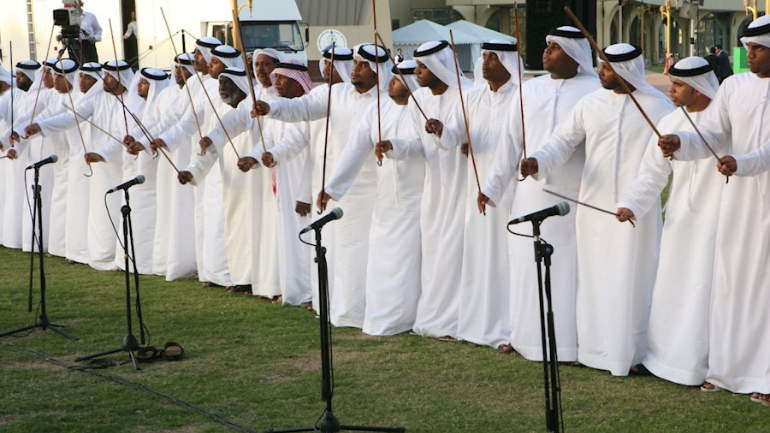
Al-Ayyala, perhaps the most well-known traditional performance in the UAE, is an expressive traditional cultural performance in which men and boys wield thin bamboo canes and walk in synchronization to a steady drumbeat. Al-Ayyala is a dance group with poetry, chants, and drummers that is performed during weddings, national holidays, and other events, as well as welcome ceremonies for visiting heads of state.
Al-Ayyala is deeply ingrained in UAE culture, exemplifying the ethos and bravery of Bedouin life while also reinforcing the principles of dignity and honor. Because it symbolizes Emirati culture’s traditions and ideals, the performance has become a symbol of national identity and unity, and it is an essential aspect of celebrations.
Read more: UAE Mangrove Forests; National mangroves forest in Emirates Dubai, Abu Dhabi
UAE Folk Dance
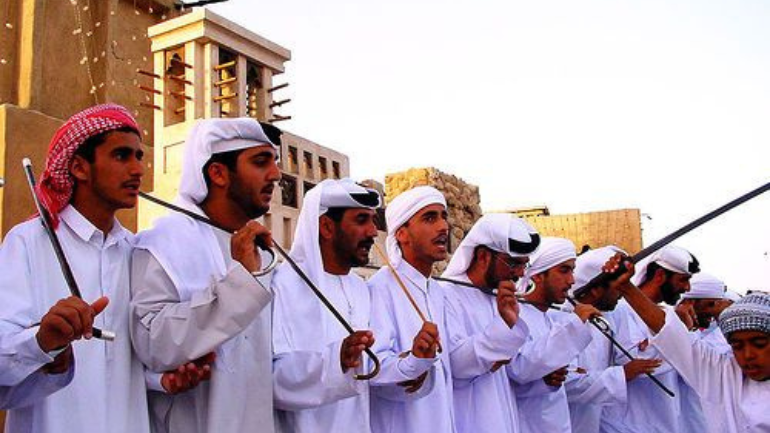
The modern renaissance of the United Arab Emirates has brought many positive developments to its citizens. Unfortunately, progress can destroy tradition. Each nation’s tradition is a unique treasure that is quickly eroded by rapid cultural globalization. The Emirates has a long history of Bedu and townsfolk. Traditional folkloric dance has long been the most authentic and popular form of cultural expression for both, appearing at festivals, national holidays, weddings, and even casual meetings of friends. This unique art form combines dance and poetry to celebrate the national spirit.
The national government and municipal governments are encouraging the preservation of cultural traditions to prevent them from being forgotten during periods of rapid societal change. For example, the Ministry of National Heritage supports the National Folk Arts Group. This patriotic ensemble performs at national celebrations and represents the Emirates globally. The heritage ministries also carry out studies on the history and relevance of indigenous dances and poems.
The range of folk traditional dances in the UAE illustrates the country’s rich cultural past. The nation’s rapid industrialization does endanger its traditions, but anybody who has seen the spontaneous and lively traditional dances at local gatherings knows that the Emirates’ distinctive cultural heritage will be preserved by its devoted custodians.
Read more: UAE Architecture: Modern Marvels and Vernacular Traditions in Dubai
Lease Ayala Emirati Dancers for Events in Dubai and Abu Dhabi
Hire Ayala Emirati dancers for your event in Dubai and Abu Dhabi. A team consists of professional dancers with years of expertise. Professional Arabic dancers can perform at any occasion, including weddings, business events, and government events, to showcase the history of Emirati culture in your show, party, or move-in cleaning services. Dancers will perform the classic Arabic sword dance with their sticks and drums facing each other while singing simultaneously! This is a historic Beduin tribal dance derived from millennia of desert customs shared by Middle Eastern cultures. This dance goes by various names, including Yowla, Al Yowla, and Stick Dance, all of which have the same meaning in the spirit of UAE culture.
Read more: UAE Groundwater Reserves: Abu Dhabi’s Arab Water Resources and Groundwater Recharge Levels
What is the traditional dance of the UAE?
Al Ayyala, the most well-known traditional dance in the UAE, is performed by both men and boys at weddings, national holidays, and other festivals.
What is the Arabic stick dance called?
The Al Ayyala dance, which represents Emirati ideals and heritage, features male performers clutching thin bamboo canes and marching to the steady rhythm of drums.
What is that Arab dance called?
The belly dance, ardah, and dabke are some of the most well-known Arab traditional dances. Traditional dancing is still popular among expatriate Arabs, and it has been successfully exported to foreign folk dance groups around the world.
What is Ayala in UAE?
Al-Ayyala is a popular and expressive cultural performance practiced in northwestern Oman and in the United Arab Emirates. Al-Ayyala incorporates chanted poetry, drum music, and dancing to recreate a battle scene.
UAE Dance is more than just a performance; it is a living embodiment of Emirati values and heritage. From the captivating rhythms of Al Ayala to the energetic stick dance, each dance form tells a story of the United Arab Emirates’ rich history. Emirati women and men participate, showcasing their culture through vibrant music and choreography. Whether viewed in a UAE dance video or experienced live, these traditional dances, including the famous Al Ayyala, offer a deep connection to the past and a celebration of national pride.
